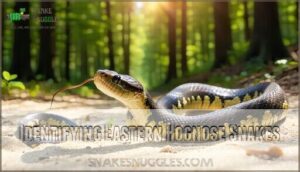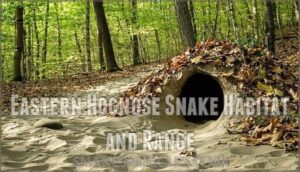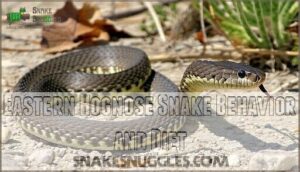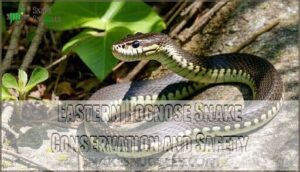This site is supported by our readers. We may earn a commission, at no cost to you, if you purchase through links.
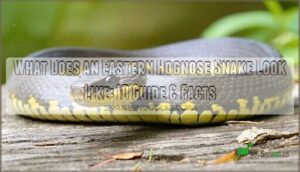 You’ll instantly recognize an eastern hognose snake by its signature upturned snout that resembles a pig’s nose – nature’s own little shovel for digging through sandy soil.
You’ll instantly recognize an eastern hognose snake by its signature upturned snout that resembles a pig’s nose – nature’s own little shovel for digging through sandy soil.
These chunky serpents measure 20-33 inches long with thick, stout bodies that taper dramatically near the tail.
Their appearance varies wildly, from vibrant orange and red to muted brown, gray, or jet black, all decorated with distinctive dark rectangular blotches running down their backs like nature’s own camouflage pattern.
The keeled scales give them a rough, sandpaper-like texture, while their broad triangular heads feature round pupils and golden-brown eyes.
What does an eastern hognose snake look like when threatened? That’s where things get really interesting.
Table Of Contents
- Key Takeaways
- Eastern Hognose Snake Appearance
- Identifying Eastern Hognose Snakes
- Eastern Hognose Snake Habitat and Range
- Eastern Hognose Snake Behavior and Diet
- Eastern Hognose Snake Conservation and Safety
- Frequently Asked Questions (FAQs)
- What does an eastern hognose snake look like?
- How long is a hognose snake?
- Are eastern hognose snakes venomous?
- What does a hog-nosed snake look like?
- What is the difference between Eastern and southern hognose snakes?
- What does an Eastern Hognose Snake do?
- How do you identify an eastern hognose snake?
- Are eastern hognose snakes good to have around?
- What states do eastern hognose snakes live in?
- How venomous is a eastern hognose snake?
- Conclusion
Key Takeaways
- You’ll recognize an eastern hognose snake by its signature upturned snout that looks like a pig’s nose—it’s their most distinctive feature for digging through sandy soil.
- They’re thick-bodied snakes measuring 20-33 inches long with rough, keeled scales that feel like sandpaper, unlike smooth-scaled species.
- Their coloration varies dramatically from bright orange and red to brown, gray, or black, all featuring dark rectangular blotches running down their backs.
- When threatened, they’ll perform dramatic defensive displays including flattening their necks like a cobra, hissing loudly, and even flipping upside-down to play dead.
Eastern Hognose Snake Appearance
You’ll recognize an eastern hognose snake by its distinctive upturned snout and thick, stout body that typically measures 20-33 inches long, with females growing larger than males.
Their appearance varies dramatically in color—from bright orange and red to brown, gray, or black—but they’re always marked with dark rectangular blotches that create excellent camouflage in their sandy woodland habitats, which is a key factor for their survival due to the distinctive markings.
Body Shape and Size
How big does an eastern hognose snake actually get? You’re looking at a chunky, robust snake that’s built like a wrestling champion rather than a marathon runner.
Adult dimensions typically reach 20-33 inches, though some females stretch to an impressive 46 inches.
Sexual dimorphism shows females consistently outgrowing males in both hognose snake length and weight range.
These snake physical characteristics include a distinctly thick midsection that tapers abruptly near the tail, giving them their characteristic stout appearance.
The eastern hognose snake has a unique build, and its size can vary, but it is generally recognized by its robust body.
Color Patterns and Variations
Eastern Hognose Snake color patterns vary dramatically across their range.
You’ll find blotched variations from brown and gray to vibrant orange and red. Regional colors show southern populations displaying darker, reddish patterns while northern snakes often sport muted grays.
Juvenile markings appear more contrasting than adults. Melanistic forms create nearly solid black snakes, while rare albinism produces pale specimens lacking dark pigmentation completely.
These snakes are known for their dramatic defensive behaviors, which can include playing dead.
Scale Patterns and Texture
When you run your hand along an Eastern Hognose Snake, you’ll immediately notice the keeled scales that create a distinctly rough texture.
Those keeled scales feel like nature’s sandpaper—designed for digging through sandy soil
Those keeled scales feel like nature’s sandpaper—designed for digging through sandy soil.
These ridged scales aren’t just for show—they’re functional tools that help the snake navigate through sandy soils and leaf litter.
Here’s what makes their scale texture unique:
- Keeled scales feature a raised ridge down the center, creating that signature rough skin feel
- Dorsal blotches appear more pronounced due to the textured surface catching light differently
- Pattern variations become more visible as the rough scale texture enhances contrast between colors
This rough skin texture sets hognose snakes apart from their smooth-scaled cousins.
The keeled scale description helps distinguish them from similar species, as most other snakes in their range have smoother surfaces.
Understanding hognose snake markings becomes easier once you recognize how the scale texture affects their overall appearance pattern.
Head Shape and Snout
Unlike other snakes, you’ll immediately recognize the eastern hognose snake’s dramatically upturned snout—nature’s perfect digging tool.
This distinctive rostral scale lifts sharply upward, creating the signature "pig nose" appearance that makes hognose snake identification foolproof.
| Feature | Description | Function |
|---|---|---|
| Snout Shape | Sharply upturned rostral scale | Digging through sandy soil |
| Head Structure | Broad, triangular with wide neck | Defensive displays and feeding |
| Jaw Alignment | Strong, well-defined jawline | Gripping slippery prey like toads |
Eye Color and Shape
When examining hognose snake eyes, you’ll notice three distinctive features that aid in identification. Pupil Shape: Round pupils, not vertical slits as commonly misidentified. Iris Color: Beautiful copper to golden brown hues that catch sunlight. Eye Size: Proportionally smaller than the broad head, creating a gentle expression.
Here’s what makes their gaze memorable:
- Round pupils that stay consistent – unlike venomous snakes with changing vertical slits
- Warm copper tones – creating an almost friendly appearance that belies their dramatic defensive displays
- Small, alert eyes – perfectly sized for spotting their favorite toad prey in sandy soil
Identifying Eastern Hognose Snakes
You’ll often spot these distinctive snakes by their most famous feature – that unmistakable upturned snout that looks like a tiny pig nose, perfect for rooting through sandy soil.
While their dramatic defensive displays might fool you into thinking they’re dangerous, learning their key identifying markers will help you confidently recognize this harmless trickster in the wild, by understanding their defensive displays.
Distinguishing Features
When you spot an eastern hognose snake, you’ll notice three standout features that make identification straightforward.
The upturned snout snake’s most obvious trait is its pointed, shovel-like nose that curves upward. This hognose snake appearance feature helps them dig through sandy soil.
The snake scale description includes keeled (ridged) scales that feel rough to touch, unlike smooth-scaled species.
Their hognose snake color and hognose snake pattern display variable backgrounds with distinctive dark rectangular blotches running down their backs.
Distinguishing Features Description
Comparison With Similar Species
Several lookalike species can confuse novice snake identification efforts.
Morphological differences help distinguish eastern hognose from copperheads, which have triangular heads and elliptical pupils versus the hognose’s round pupils.
Milk snakes lack the upturned snout snake feature and show distinct red-black-white banding.
Rat snakes have smooth scales, contrasting with hognose’s keeled texture.
The snake head shape and dramatic defensive displays separate hognose from most species comparison candidates.
Key Identification Characteristics
When identifying hognose snake size and features, focus on these key traits.
The upturned Snout Shape acts like nature’s shovel, perfectly adapted for digging.
Scale Texture feels rough due to keeled ridges, unlike smooth-scaled cousins.
Color Patterns vary dramatically – from sandy browns to striking oranges with dark rectangular blotches.
Body Size reaches 20-33 inches, with females typically larger than males.
The broad Head Features include round pupils and can flatten dramatically when threatened.
Key identification markers that’ll help you spot an eastern hognose snake:
- That unmistakable pig-nose snout that points skyward
- Rough, ridged scales that feel like sandpaper
- Bold dorsal blotches resembling eyespots along the back
- Thick, robust body that tapers abruptly near the tail
Common Misidentifications
Eastern hognose snake misidentification causes stem from their variable coloration and body shape.
You’ll often confuse them with Southern Hognose, Eastern Garter Snakes, or King Snakes since these lookalike snakes share similar dorsal patterns.
False identities occur because snake mimicry makes identifying hognose challenging—their earth-tone colors and dark blotches resemble other species perfectly, which is due to their ability to blend in with their surroundings through variable coloration.
Expert Identification Tips
The secret to accurate eastern hognose snake identification lies in mastering five key features.
Focus on their distinctive upturned snout shape, which sets them apart from all other species.
Examine the keeled scale texture that feels rough to touch.
Notice their variable color patterns with prominent dark blotches creating striking dorsal patterns.
Consider their stout body size and broad head features when making your determination.
- Picture a tiny pig’s snout on a snake – that upturned rostral scale is unmistakable
- Imagine running your finger along sandpaper – those keeled scales create that characteristic rough texture
- Visualize chocolate chips scattered across cookie dough – those dark blotches stand out against lighter backgrounds
Eastern Hognose Snake Habitat and Range
You’ll find eastern hognose snakes across a vast range spanning from southern Canada down to Florida and west to Texas, making them one of North America’s most widely distributed snake species.
These adaptable reptiles thrive in diverse environments including sandy woodlands, coastal plains, farmlands, and open fields where loose soil allows for their signature burrowing behavior.
They inhabit areas where the environment supports their lifestyle, including diverse environments.
Geographic Distribution
Across eastern North America’s vast landscape, you’ll discover eastern hognose snakes from southern Canada down to Florida and Texas.
These adaptable reptiles inhabit much of the eastern United States, with populations densest in coastal plains and sandy regions.
| Region | Coverage |
|---|---|
| Northern Range | Southern Ontario to Minnesota |
| Southern Range | Florida to Texas Gulf Coast |
| Eastern Extent | Atlantic Coast to Great Lakes |
| Western Limit | Eastern edges of Great Plains |
Preferred Habitats
Finding the perfect habitat feels like discovering the eastern hognose snake’s favorite neighborhood. These adaptable reptiles thrive in specific environments that meet their unique needs.
You’ll find eastern hognose snakes flourishing in these preferred habitat types:
- Sandy Soils and Coastal Plains: Well-drained, loose substrates allow easy burrowing and foraging
- Forest Edges and Woodland Areas: Mixed habitats provide cover while maintaining open hunting grounds
- Field Habitats: Grasslands and meadows offer abundant prey and suitable nesting sites
- Pine Barrens: These specialized ecosystems combine sandy soil with sparse vegetation perfectly
Their habitat selection isn’t random—eastern hognose snakes need loose, workable soil for their digging lifestyle. You’ll rarely spot them in dense forests or rocky terrain where burrowing becomes impossible. The snakes’ preference for sandy soil types is essential for their survival and nesting habits.
Environmental Adaptations
Nature’s toolkit perfectly equips eastern hognose snakes for survival through specialized environmental adaptations.
These remarkable reptiles excel at thriving in challenging conditions using their built-in survival strategies.
Understanding hognose snake care is essential for recreating their natural habitat.
| Adaptation | Function | Benefit |
|---|---|---|
| Burrowing Techniques | Upturned snout digs sandy soil | Escapes predators, finds prey |
| Heat Tolerance | Behavioral thermoregulation | Active during ideal temperatures |
| Camouflage Methods | Variable coloration patterns | Blends with leaf litter |
Migration Patterns
Unlike many snakes, eastern hognose snakes don’t undertake long-distance seasonal movements. Instead, their migration patterns involve short relocations within their geographic range, typically moving less than half a mile daily.
Temperature changes and humidity effects trigger these movements as they search for ideal soil preference conditions.
During spring breeding season, males travel farther to locate females, while winter forces deeper burrowing into suitable substrates within their established territories.
Human Interaction and Habitat Disruption
Human activities pose significant threats to eastern hognose snake populations through habitat loss and environmental degradation.
Urban development destroys sandy soils these snakes need for burrowing, while agricultural expansion fragments their territories.
Pesticide use reduces toad populations—their primary food source. Soil erosion from construction eliminates suitable nesting sites.
Road mortality increases as snakes cross developed areas.
Wildlife conservation efforts focus on preserving open woodlands and coastal plains where these masters of defensive behavior can thrive undisturbed.
Eastern Hognose Snake Behavior and Diet
Understanding eastern hognose snake behavior helps you identify these fascinating reptiles in the wild and appreciate their unique survival strategies.
You’ll discover how their dramatic defensive displays and specialized diet make them one of North America’s most interesting snake species.
Feeding Habits and Prey
Eastern Hognose snakes are toad specialists, with amphibians comprising 75% of their natural diet.
Their rear fangs deliver mild venom to subdue struggling prey during swallowing.
Primary prey includes:
- Toads – American toads make up most meals
- Frogs and salamanders – Secondary amphibian targets
- Small mammals – Mice when amphibians aren’t available
Their feeding behavior centers on toad predation, using venom delivery for effective prey capture.
Hunting Strategies
You’ll find these snakes using their signature upturned snout as nature’s perfect shovel.
Their hunting techniques revolve around burrowing methods that let them root through sandy soil like a pig hunting truffles.
Ambush tactics dominate their foraging strategies – they’ll dig systematically until detecting toad scent, then strike with lightning speed.
Their snake body type supports this prey capture approach perfectly.
Understanding snake behavior patterns, including defensive postures, is essential for appreciating the Eastern Hognose Snake’s unique characteristics.
| Hunting Strategy | Description |
|---|---|
| Scent Detection | Uses forked tongue to locate buried toads |
| Soil Excavation | Upturned snout digs through loose sand |
| Ambush Positioning | Waits motionless near burrows |
| Strike Technique | Quick bite followed by mild venom injection |
| Swallowing Method | Consumes prey headfirst underground |
Defensive Mechanisms
When threatened, you’ll witness the eastern hognose snake’s impressive defensive arsenal.
These theatrical performers don’t mess around when danger approaches
These theatrical performers don’t mess around when danger approaches.
Their defensive mechanisms include three main strategies:
- Cobra mimicry – They flatten their necks wide while producing loud hissing sounds to appear more intimidating
- Playing dead – If threats persist, they’ll flip upside-down with mouths agape, complete with fake blood
- Camouflage tactics – Their blotched patterns help them blend seamlessly into leaf litter and sandy soils
This faking death behavior often convinces predators they’re dealing with a rotting carcass rather than a meal.
Social Behavior and Interaction
Beyond their famous death-feigning theatrics, you’ll find Eastern Hognose snakes are surprisingly antisocial creatures.
These solitary reptiles prefer their own company, rarely interacting except during spring mating rituals.
Their social behavior revolves around subtle territorial behavior and minimal snake communication through scent marking and occasional body language displays.
- Mating rituals occur once yearly in spring, with males tracking female pheromones across territories
- Social hierarchy doesn’t exist—these snakes maintain equal status with overlapping home ranges
- Interaction patterns involve brief encounters, usually resulting in one snake moving away peacefully
- Group dynamics shift only during winter hibernation when multiple snakes share underground dens
- Docile behavior extends to interspecies encounters, making them non-aggressive toward humans and other wildlife
Reproductive Behavior
Spring arrives with nature’s matchmaking show, as males track females using chemical signals.
You’ll witness fascinating mating rituals during warmer months when these snakes emerge from winter hideouts.
During reproduction, females select ideal nesting sites in loose soil or decaying logs.
Their clutch size typically ranges from 8-25 eggs, depending on the female’s size and health.
| Reproduction Stage | Details |
|---|---|
| Mating Season | April-June, peak activity |
| Clutch Size | 8-25 eggs per female |
| Incubation Period | 50-65 days average |
| Juvenile Survival | 60-70% hatch successfully |
Hatchlings emerge as miniature versions of adults, measuring just 6-8 inches long but possessing the same dramatic defensive behaviors that make these snakes so memorable.
Eastern Hognose Snake Conservation and Safety
You’ll find that eastern hognose snakes face various conservation challenges, though they’re not currently endangered.
Learning proper identification and safety practices helps protect both you and these remarkable snake species when encounters occur in the wild, which is crucial for safety.
Conservation Status
Understanding eastern hognose snakes helps us appreciate why conservation status matters for these remarkable creatures.
The International Union for Conservation of Nature (IUCN) currently lists them as "Least Concern" globally, but population trends tell a more complex story.
While stable in southeastern regions, declining populations plague northeastern states where habitat loss fragments their sandy soil homes.
Twelve states now provide legal protections through conservation efforts and trade restrictions.
- Watching a wild hognose snake perform its dramatic "death" act reminds us what we might lose
- Every sandy patch of habitat destroyed means fewer places for these gentle comedians to thrive
- Local populations vanishing forever, leaving empty spaces where curious snouts once rooted
- Children growing up without discovering these harmless, fascinating neighbors in their backyards
- Scientists racing against time to understand threats before it’s too late for recovery
Threats and Decline
Eastern hognose snakes face mounting challenges across their range.
Habitat loss from urban development destroys the sandy soils they need for burrowing. Road mortality kills countless snakes as they cross pavement.
Climate change shifts their preferred temperature zones northward. Many people still practice intentional killing despite their harmless nature.
Declining populations reflect these combined pressures, creating genuine extinction risks in fragmented habitats where conservation status remains precarious.
Safety Precautions and Handling
When handling these venomless serpents, your safety depends on respecting their space and using proper techniques. Never grab wild eastern hognose snakes with bare hands—use snake hooks or protective gear instead.
If you must handle one, grasp firmly behind the head while supporting the body, avoiding sudden movements that trigger defensive mechanisms. Using the right snake handling tools is essential for safety.
- Watch for their dramatic "death" performance—they’ll flip upside down with mouth agape
- Keep children and pets at safe distance during encounters
- Have an emergency response plan ready, even though bites rarely cause serious harm
- Remember their bite prevention strategy: they’d rather bluff than actually strike
Venom and Bite Risks
You won’t lose sleep over eastern hognose snake bite risks. While technically venomous, these serpents rarely bite humans, and their mild venom poses minimal threat to people.
Understanding the hognose snake behavior is essential for effective conservation efforts.
| Venom Component | Human Risk Level | Typical Symptoms |
|---|---|---|
| Rear fangs deliver toxin | Very low danger | Minor swelling, irritation |
| Mild potency for amphibians | Nonvenomous to humans | Local pain at bite site |
| Rarely used defensively | No medical emergencies | Redness, possible itching |
| Effective against toads | Poisonless for most mammals | Subsides within hours |
| Limited venom delivery | Safe when given space | Clean wound, monitor healing |
Research and Citizen Science Opportunities
Beyond understanding bite risks, you can actively support eastern hognose snake conservation through citizen science.
Your observations matter—every sighting helps researchers track Heterodon platirhinos populations and understand their snake dorsal pattern variations.
Effective conservation relies on utilizing proper citizen science tools to collect and analyze data.
- Data Collection: Document snake ventral pattern details and color patterns through photography
- Species Monitoring: Report sightings to local herpetological societies and wildlife agencies
- Citizen Engagement: Join community surveys tracking eastern hognose snake habitat changes
- Research Funding: Support science outreach programs studying these remarkable mimics
Frequently Asked Questions (FAQs)
What does an eastern hognose snake look like?
Ironically, you’d think such a dramatic snake would be flashy, but eastern hognose snakes sport surprisingly earthy camouflage.
You’ll spot their upturned snout, stout body, keeled scales, and variable colors from brown to orange with dark blotches, which are key features of the hognose snakes.
How long is a hognose snake?
You’ll find eastern hognose snakes typically measure 20-30 inches long, with females growing larger than males.
The longest recorded female reached an impressive 46 inches, though most adults stay closer to that 28-inch average length.
Are eastern hognose snakes venomous?
Don’t judge a book by its cover—eastern hognose snakes are technically venomous but harmless to you.
They’ve rear fangs and mild venom designed for toads, not humans, making them safe pets and neighbors.
What does a hog-nosed snake look like?
You’ll recognize a hog-nosed snake by its distinctive upturned, shovel-like snout that’s perfect for digging.
They’re stout-bodied, reaching 20-30 inches long, with highly variable colors including brown, gray, orange, or yellow featuring dark rectangular blotches along their backs.
What is the difference between Eastern and southern hognose snakes?
Ever wondered what sets these two hognose cousins apart?
You’ll spot key differences: Eastern hognose snakes are larger with more varied colors, while Southern hognose snakes stay smaller with consistently lighter, sandy tones and less dramatic defensive displays, showing complete concepts of size and color variation, and key differences in defensive behavior.
What does an Eastern Hognose Snake do?
You’ll see Eastern hognose snakes primarily hunt toads using mild venom from rear fangs.
They’re expert diggers, burrowing in sandy soil with their upturned snouts, and dramatically fake death when threatened.
How do you identify an eastern hognose snake?
Like nature’s master of disguise, you’ll spot an eastern hognose snake by its signature upturned snout, keeled scales, and dramatic defensive displays including neck flattening and death-feigning when threatened.
Are eastern hognose snakes good to have around?
Eastern hognose snakes are beneficial yard companions you’ll want to keep around.
They’re harmless pest controllers that eat toads, rodents, and insects while posing zero threat to humans or pets through their theatrical defensive displays.
What states do eastern hognose snakes live in?
Believe it or not, back in Pony Express days, you’d find eastern hognose snakes across twenty-four states.
They range from southern Canada to Florida, stretching west through Minnesota, Iowa, Kansas, and into eastern Texas, which is a significant part of their habitat.
How venomous is a eastern hognose snake?
Eastern hognose snakes aren’t truly venomous to humans.
They’re rear-fanged with mild venom that’s effective against toads, their primary prey.
You’d experience only minor irritation if bitten, similar to a bee sting, making them practically harmless to people.
Conclusion
Ready to spot an eastern hognose snake in the wild?
Now you know what an eastern hognose snake looks like – from that distinctive upturned snout to the dramatic defensive displays that make them nature’s greatest actors.
Remember their thick, blotched bodies, keeled scales, and variable coloration ranging from vibrant orange to jet black.
With these identification features in mind, you’ll confidently distinguish them from similar species while respecting their important role in controlling rodent populations throughout their eastern North American range, and appreciate their value as part of the ecosystem with dramatic defensive displays.
- https://academicguides.waldenu.edu/reading-skills/identifying-main-idea
- https://www.animalspot.net/eastern-hognose-snake.html
- https://www.agfc.com/news/big-faker-eastern-hognose-is-arkansass-counterfeit-cobra/
- https://www.outdooralabama.com/non-venomous-snakes/eastern-hognose-snake
- https://en.wikipedia.org/wiki/Eastern_hognose_snake

